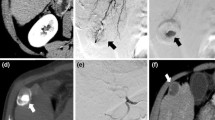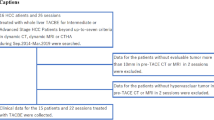Abstract
The purpose of this study is to report on the feasibility, local response, and 1-year clinical outcome of bland transarterial embolization (TAE) with 40- and 100-μm Embozene microspheres in patients affected by unresectable hepatocellular carcinoma (HCC). Up to January 2009, 53 patients underwent superselective TAE for a total of 74 lesions. Diagnosis of HCC was based on multidetector computed tomography (MDCT), α-fetoprotein, and biopsy. MDCT was performed 24 after treatment and repeated at 1 month, 3 months, and then every 6 months. Local efficacy was defined according to RECIST criteria. Technical success was always achieved. Local results at 1-month, 3- to 6-month, and 6- to 12-month follow-up were 62%, 37%, and 16%, respectively, for stable disease and 35%, 56%, and 51%, respectively, for partial response. Complete response (no evidence of lesion) has been observed only at late follow-up (three lesions; 7%). To date, 20 of 53 patients have had at least 1 year of follow-up, with an overall survival rate of 96%. Hepatic progressive disease (i.e., new nodules) was observed in 14 of 20 patients due to underlying liver disease. Minor complications were observed in four patients. A major complication occurred in one patient, who died unexpectedly 24 h after TAE due to pulmonary embolism of necrotic pathologic tissue and passage of particles through a disrupted hepatic vein. Local results as well as 1-year clinical outcome after TAE with Embozene microspheres are veryly encouraging, however, further studies, a larger patient population, and a longer follow-up are mandatory to assess the real clinical impact.


Similar content being viewed by others
References
Alba E, Valls C, Dominguez J et al (2008) Trancatheter arterial chemoembolization in patients with hepatocellular carcinoma on the waiting list for orthotopic liver transplantation. AJR 190(5):1341–1348
Parkin DM, Bray F, Ferlay J et al (2002) Global cancer statistics 2002. CA Cancer J Clin 55(2):74–108
El-Serag HB, Mason AC (1999) Rising incidence of hepatocellular carcinoma in the United States. N Engl J Med 340(10):745–750
El-Serag HB, Davial JA, Petersen NJ et al (2003) The continuing increase in the incidence of hepatocellular carcinoma in the United States: an update. Ann Intern Med 139(10):817–823
Llovet JM, Real MI, Montana X et al (2002) Arterial embolisation or chemoembolization versus symptomatic treatment in patients with unresectable hepatocellular carcinoma: a randomised controlled trial. Lancet 359(9319):1734–1739
Schwartz M, Roayaie S, Konstadoulakis M (2007) Strategies for the management of hepatocellular carcinoma. Nat Clin Pract Oncol 4(7):424–432
Clark HP, Carson WF, Kavanagh PV et al (2005) Staging and current treatment of hepatocellular carcinoma. Radiographics 25(Suppl 1):S3–S23
Llovet JM, Burroughs A, Bruix J (2003) Hepatocellular carcinoma. Lancet 362(9399):1907–1917 [review]
Lubienski A (2005) Hepatocellular carcinoma: interventional bridging to liver transplantation. Transplantation 80(Suppl 1):S113–S119
Bruix J, Sala M, Llovet JM (2004) Chemoembolization for hepatocellular carcinoma. Gastroenterology 127(5 Suppl 1):179–188
Camma C, Schepis F, Orlando A et al (2002) Transarterial chemoembolization for unresectable hepatocellular carcinoma: meta-analysis of randomized controlled. Radiology 224(1):47–54
Llovet JM, Bruix J (2003) Systematic review of randomized trials for unresectable hepatocellular carcinoma: chemoembolization improves survival. Hepatology 37(2):429–442
Bruix J, Sherman M, Llovet JM et al (2001) Clinical management of hepatocellular carcinoma. Conclusions of the Barcelona-2000 EASL Conference, for the EASL Panel of Experts on HCC. J Hepatol 35(3):421–430
Arakawa A, Nishiharu T, Matsukawa T et al (1996) Detection of hepatocellular carcinoma by intraarterially enhanced ultrasonography with CO2 microbubbles. Comparison with DSA, dynamic CT, and Lipiodol CT. Acta Radiol 37(3 Pt 1):250–254
Merlino R, Orsi F, Bezzi M et al (1994) Carbon dioxide as an intra-arterial contrast agent in echography: a technique for its preparation and the preliminary results in assessing hepatocarcinoma vascularisation. Radiol Med 88(3):259–265
Salem R, Thurston KG (2006) Radioembolization with 90yttrium microspheres: a state-of-the-art brachytherapy treatment for primary and secondary liver malignancies. Part 1: Technical and methodologic considerations. J Vasc Interv Radiol 17(8):1251–1278
Chen JH, Chai JW, Huang CL et al (1999) Proximal arterioportal shunting associated with hepatocellular carcinoma: features revealed by dynamic helical CT. AJR 172(2):403–407
Hung JC, Redfern MG, Mahoney DW et al (2000) Evaluation of macroaggregated albumin particle sizes for use in pulmonary shunt patient studies. J Am Pharm Assoc 40(1):46–51
Brown DB, Cardella JF, Sacks D et al (2006) Quality improvement guidelines for transhepatic arterial chemoembolization, embolization and chemotherapeutic infusion for hepatic malignancy. J Vasc Interv Radiol 17:225–232
Llovet JM, Brù C, Bruix J (1999) Prognosis of hepatocellular carcinoma: the BCLC staging classification. Semin Liver Dis 19(3):329–339
Lo CM, Ngan H, Tso WK et al (2002) Randomized controlled trial of trasarterial lipiodol chemoembolization for unresectable hepatocellular carcinoma. Hepatology 35(5):1164–1171
Miraglia R, Pietrosi G, Maruzzelli L et al (2007) Efficacy of transcatheter embolization/chemoembolization (TAE/TACE) for the treatment of single hepatocellular carcinoma. World J Gastroenterol 13(21):2953–2955
Lin DY, Lee TY, Liaw YF et al (1988) Hepatic arterial embolization in patients with unresectable hepatocellular carcinoma: a randomized controlled trial. Gastroenterology 94(2):453–456
Pelletier G, Roche A, Ink O et al (1990) A randomized trial of hepatic arterial chemoembolization in patient with unresectable hepatocellular carcinoma. J Hepatol 11(2):181–184
Madden MV, Krige JE, Bailey S et al (1993) Randomised trial of targeted chemotherapy with lipiodol and 5-epidoxorubicin compared with symptomatic treatment for hepatoma. Gut 34(11):1598–1600
Bruix J, Llovet JM, Castells A et al (1998) Transarterial embolization versus symptomatic treatment in patients with advanced HCC: results of randomized controlled trial in a single institution. Hepatology 27(6):1578–1583
Pelletier G, Ducreux M, Gay F et al (1998) Treatment of unresectable hepatocellular carcinoma with lipiodol chemoembolization: a multicenter randomized trial. J Hepatol 29(1):129–134
Grosso M, Vignali C, Quaretti P et al (2008) Transarterial chemoembolization for hepatocellular carcinoma with drug-eluting microspheres: preliminary results from an Italian multicentre study. CardioVasc Interv Radiol 31(6):1141–1149
Marelli L, Stigliano R, Triantos C et al (2007) Transarterial therapy for hepatocellular carcinoma: which technique is more effective? A systematic review of cohort and randomized studies. CardioVasc Interv Radiol 30(1):6–25
Llovet JM, Real MI, Montana X et al (2002) Arterial embolisation or chemoembolisation versus symptomatic treatment in patients with unresectable hepatocellular carcinoma: a randomised controlled trial. Lancet 359:1734–1739
Ramsey DE, Kernagis LY, Soulen MC et al (2002) Chemoembolization of hepatocellular carcinoma. J Vasc Interv Radiol 13(9; Pt 2):211–221
Mathupala SP, Rempel A, Pedersen PL (2001) Glucose catabolism in cancer cells: identification and characterization of a marked activation response of the type II hexokinase gene to hypoxic conditions. J Biol Chem 276(46):43407–43412
Tajima T, Honda H, Taguchi K et al (2002) Sequential hemodynamic change in hepatocellular carcinoma and dysplastic nodules: CT angiography and pathologic correlation. AJR 178(4):885–897
Lee KH, Liapi E, Vossen JA et al (2008) Distribution of iron oxide-containing embosphere particles after transcatheter arterial embolization in an animal model of liver cancer: evaluation with MR imaging and implicationfor therapy. J Vasc Interv Radiol 19:1490–1496
Jones JA, Chang DT, Meyerson H et al (2007) Proteomic analysis and quantification of cytokines and chemokines from biomaterial surface-adherent macrophages and foreign body giant cells. J Biomed Mater Res A 83:585–596
Kobayashi N, Ishii M, Ueno Y et al (1999) Co-expression of Bel-2 protein and vascular endothelial growth factor in hepatocellular carcinomas treated by chemoembolization. Liver 19(1):25–31
Liou TC, Shih SC, Kao CR et al (1995) Pulmonary metastasis of hepatocellular carcinoma associated with transarterial chemoembolization. J Hepatol 23(5):563–568
Sergio A, Cristofori C, Cardin R et al (2008) Transcatheter arterial chemoembolization (TACE) in hepatocellular carcinoma (HCC): the role of angiogenesis and invasiveness. Am J Gastroenterol 103(4):914–921
Mamori S, Asakura T, Ohkawa K et al (2007) Survivin expression in early hepatocellular carcinoma and post-treatment with anticancer drug under hypoxic culture condition. World J Gastroenterol 13(40):5306–5311
Laurent A, Wassef M, Chapot R et al (2004) Location of vessel occlusion of calibrated tris-acryl gelatin microspheres for tumor and arteriovenous malformation embolization. J Vasc Interv Radiol 15:491–496
Dion JE, Rankin RN, Vinuela F et al (1986) Dextran microsphere embolization: experimental and clinical experience with radiologic-pathologic correlation. Radiology 160:717–721
Pillaj KM, McKeever PE, Knutsen CA et al (1991) Microscopic analysis of arterial microsphere distribution in rabbit liver and hepatic VX2 tumor. Sel Cancer Ther 7(2):39–48
Yamamoto A, Imai S, Kobatake M et al (2006) Evaluation of tris-acryl gelatine microsphere embolization with monochromatic X-rays: comparison with polyvinyl alcohol particles. J Vasc Interv Radiol 17:1797–1802
Lee KH, Liapi E, Vossen JA et al (2008) Distribution of iron oxide-containing Embosphere particles after transcatheter arterial embolization in an animal model of liver cancer: evaluation with MR Imaging and implication for therapy. J Vasc Interv Radiol 19(10):1490–1496
Amseur NB, Zajko AB, Carr BI (2008) Chemo-embolization for unresectable hepatocellular carcinoma with different sizes of embolization particles. Dig Dis Sci 53(5):1400–1404
Maluccio MA, Covey AM, Porat LB et al (2008) Transcatheter arterial embolization with only particles for the treatment of unresectable hepatocellular carcinoma. J Vasc Interv Radiol 19(6):862–869
Stampfl U, Stampfl S, Bellemann N et al (2009) Experimental liver embolization with four different spherical embolic materials: impact on inflammatory tissue and foreign body reaction. CardioVasc Interv Radiol 32(2):303–312
Bilbao JI, de Martino A, de Luis E et al (2009) Biocompatibility, inflammatory response, and recannalization characteristics of nonradioactive resin microspheres: histological findings. CardioVasc Interv Radiol 32(4):727–736
Brown KT (2004) Fatal pulmonary complications after arterial embolization with 40–120 μm tris-acryl gelatine microspheres. J Vasc Interv Radiol 15(2; Pt 1):197–200
Noguera PJJ, Martinez-Cuesta A, Sangro B et al (2008) Embolismo pulmonary fatal tras la embolizaciòn con microsferas de un hepatocarcinoma. Radiologia 50:248–250
Author information
Authors and Affiliations
Corresponding author
Rights and permissions
About this article
Cite this article
Bonomo, G., Pedicini, V., Monfardini, L. et al. Bland Embolization in Patients with Unresectable Hepatocellular Carcinoma Using Precise, Tightly Size-Calibrated, Anti-Inflammatory Microparticles: First Clinical Experience and One-Year Follow-Up. Cardiovasc Intervent Radiol 33, 552–559 (2010). https://doi.org/10.1007/s00270-009-9752-y
Received:
Accepted:
Published:
Issue Date:
DOI: https://doi.org/10.1007/s00270-009-9752-y




